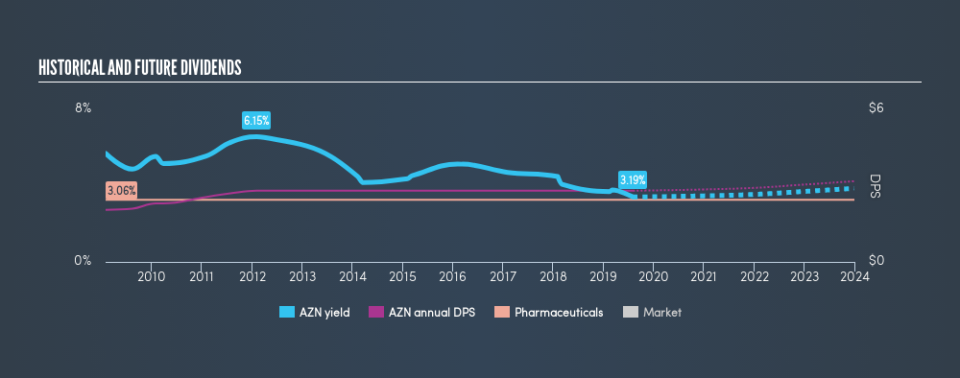It Might Be Better To Avoid AstraZeneca PLC's (LON:AZN) Upcoming 1.0% Dividend

AstraZeneca PLC (LON:AZN) is about to trade ex-dividend in the next 3 days. Ex-dividend means that investors that purchase the stock on or after the 8th of August will not receive this dividend, which will be paid on the 9th of September.
AstraZeneca's next dividend payment will be US$0.72 per share, on the back of last year when the company paid a total of US$2.80 to shareholders. Last year's total dividend payments show that AstraZeneca has a trailing yield of 3.2% on the current share price of £72.4. Dividends are an important source of income to many shareholders, but the health of the business is crucial to maintaining those dividends. So we need to check whether the dividend payments are covered, and if earnings are growing.
See our latest analysis for AstraZeneca
Dividends are typically paid out of company income, so if a company pays out more than it earned, its dividend is usually at a higher risk of being cut. AstraZeneca distributed an unsustainably high 164% of its profit as dividends to shareholders last year. Without more sustainable payment behaviour, the dividend looks precarious. A useful secondary check can be to evaluate whether AstraZeneca generated enough free cash flow to afford its dividend. It paid out 100% of its free cash flow in the form of dividends last year, which is outside the comfort zone for most businesses. Companies usually need cash more than they need earnings - expenses don't pay themselves - so it's not great to see it paying out so much of its cash flow.
Cash is slightly more important than profit from a dividend perspective, but given AstraZeneca's payments were not well covered by either earnings or cash flow, we are concerned about the sustainability of this dividend.
Click here to see the company's payout ratio, plus analyst estimates of its future dividends.
Have Earnings And Dividends Been Growing?
When earnings decline, dividend companies become much harder to analyse and own safely. If earnings decline and the company is forced to cut its dividend, investors could watch the value of their investment go up in smoke. So we're not too excited that AstraZeneca's earnings are down 3.5% a year over the past five years.
The main way most investors will assess a company's dividend prospects is by checking the historical rate of dividend growth. In the past 10 years, AstraZeneca has increased its dividend at approximately 3.2% a year on average. That's intriguing, but the combination of growing dividends despite declining earnings can typically only be achieved by paying out a larger percentage of profits. AstraZeneca is already paying out a high percentage of its income, so without earnings growth, we're doubtful of whether this dividend will grow much in the future.
The Bottom Line
From a dividend perspective, should investors buy or avoid AstraZeneca? Not only are earnings per share declining, but AstraZeneca is paying out an uncomfortably high percentage of both its earnings and cashflow to shareholders as dividends. This is a clearly suboptimal combination that usually suggests the dividend is at risk of being cut. If not now, then perhaps in the future. It's not the most attractive proposition from a dividend perspective, and we'd probably give this one a miss for now.
Ever wonder what the future holds for AstraZeneca? See what the 21 analysts we track are forecasting, with this visualisation of its historical and future estimated earnings and cash flow
A common investment mistake is buying the first interesting stock you see. Here you can find a list of promising dividend stocks with a greater than 2% yield and an upcoming dividend.
We aim to bring you long-term focused research analysis driven by fundamental data. Note that our analysis may not factor in the latest price-sensitive company announcements or qualitative material.
If you spot an error that warrants correction, please contact the editor at editorial-team@simplywallst.com. This article by Simply Wall St is general in nature. It does not constitute a recommendation to buy or sell any stock, and does not take account of your objectives, or your financial situation. Simply Wall St has no position in the stocks mentioned. Thank you for reading.

 Yahoo Finance
Yahoo Finance 
